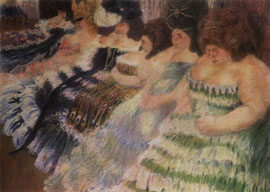
October 14, 2010

The Fat Women by Igor Grabar, 1904.
“About figures,” said Gimlet. “He made it plain well before the election that if the Conservatives took charge, the country should expect draconian measures to redress the situation Labour created. In past times, people would have tightened their belts and helped to do their bit, but now they are indolent and greedy. They don”t like having to tighten the belt, and that brings me to gold.”
Now I was properly lost.
“The European debt concern that is being driven by Portugal, Ireland, Italy, Greece, and Spain has undermined confidence in the European banking system; in fact, the euro might even fail as a currency. How, then, do you think investors might best hedge against the eurozone’s financial mess?”
“By buying gold,” I suggested.
“Precisely!” said Gimlet. “And as the euro is the reserve currency for many countries, its fall in value translates to higher prices for gold purchases made in euros. It is interesting to note at the same time that the supply-and-demand divide grows ever wider. Remember, too, that at the turn of the twentieth century South Africa produced 75% of the world’s new gold; today it’s 19%.”
“I wonder how much processed gold there is sloshing about in the world,” I said.
“Estimates put the existing stock at 165,000 metric tons, with around 2,400 tons being added each year, a growth rate of around 1.5%. Now think about this,” said Gimlet. “We have mentioned investor hedging. We know that there is an increasing imbalance in the supply/demand ratio. Consider, then, the areas where demand is growing: China and India, for example. The World Gold Council reported that consumer demand in India rose to 193.5 tons during the first quarter of 2010, up nearly 700% from the same period a year ago.”
I pointed out that in the 1990s there had been a case for arguing the supply/demand imbalance, but that hadn”t stopped gold from plummeting.
“Yes, but you are forgetting that at that time the central banks were still shifting their reserves around. For the last two decades, central banks have been net sellers of bullion, but during the past year that has reversed. Emerging nations have become net buyers of gold. China, for example, has increased its bullion reserves from 600 tons to 1,054 tons. So we have global economic and political uncertainty, a massive $13-trillion indebtedness in the USA, fears of quantitative easing, and the prospect of negative real interest rates. All this seems set to increase demand for gold. Also, if you take into account consumer price inflation since 1980 when gold was $850 an ounce, it is equivalent today to around $2,200 an ounce. Incidentally, how are our recent mining recommendations performing?”
Last week ended well for The House of Gimlet. Petra diamonds, which we recommended on August 12th when the price was 65p, closed on October 8th at 92p. And Aquarius Platinum, which we recommended on September 7th at 305p, closed at 372p. Mining stocks in general looked strong, and gold closed at $1,346.
“Very satisfying,” said Gimlet. “It is quite probable that we will see some profit-taking in the short term, but the overall prospect for gold and precious metals looks promising. For the cautious gold investor, it would be worth looking at Newmont Mining. It is one of the world’s largest and most profitable gold-mining companies, with proven and probable reserves of almost 100 million ounces.”
Sadly, I had to stop him. It was time to make our way to the Gare du Nord.
Gimlet looked wistfully out at the Champs-Ãlysées and declared: “If those women out there were worth their weight in gold, they would be fabulously rich!”